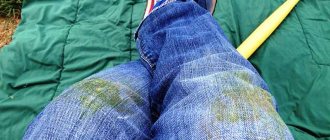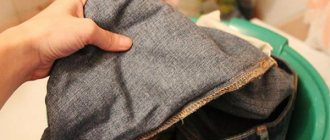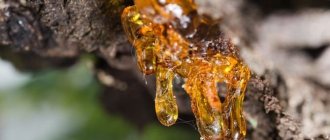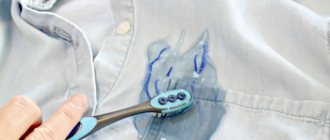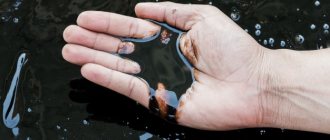While walking through a coniferous forest or doing construction and repair work in the house, you can get dirty in a viscous substance. You need to get rid of it quickly so that it doesn’t leave marks on your hands or clothes. You can wipe off the resin at home using simple improvised means. The main thing is to follow the sequence of actions and rules for removing difficult stains from certain types of fabric.
Have you encountered a similar problem?
Not really
How to remove tar from pants?
Rubbing alcohol will help remove fresh stains. To do this, soak a cotton swab in alcohol and wipe the area of contamination. Alcohol also removes resin from delicate clothes that are not intended to be washed. Pine resin can be easily washed off if you mix 1 tsp.
Interesting materials:
How to determine a major transaction by balance sheet? How to determine citric acid? How to determine the maximum resolution of a monitor? How to define a small business? How to determine the naturalness of honey at home? How to determine working capital from the balance sheet? How to determine the main activity of a company? How to identify a rooster? How to determine fabric density? How to determine the sex of geese?
Preparing for cleaning
Having discovered a dark tar stain on the leg or sleeve of a blouse, the first thing you need to do is remember how it could have appeared. If trouble occurs after a walk in a park planted with coniferous trees, or while picking mushrooms in a pine forest, then we are talking about tree resin. It’s another matter if the stain appeared during repairs or after going to a construction site. In this case, we can assume that the resin is epoxy.
Resin type – wood (natural) or epoxy
There are two types of resins: natural, or wood, and synthetic. But they are all characterized by incredible stickiness, the ability to quickly penetrate the fabric fibers and glue them together.
Before cleaning begins, it is necessary to correctly determine the type of resin.
- Tree resin (tar) is a viscous, oily liquid of a dark brown color. It is formed as a result of the hardening of the sap of some trees. Resin is produced by pine trees, spruce trees, larches, poplar buds, thuja and other plants.
- Epoxy resin is a representative of synthetic substances, as it is produced chemically. Such resins are widely used in households, construction, and manufacturing. Epoxy exhibits its binding properties only when combined with a hardener and is resistant to acids and alkalis.
Vegetable stains are much easier to remove than stains caused by epoxy resin.
Fabric material
To select a cleaning product, it is important to know what fabric the stained jacket or blouse is made of. Otherwise, a hole may form in place of the stain, the paint may peel off, or some other problem may occur.
The composition of the material and methods of caring for the product are indicated on the label. If the information is erased or the label is cut off immediately after purchase, you should follow these rules:
| Fabric type | Rules |
| Wool and natural silk | They do not tolerate exposure to strong alkaline solutions. To clean the surface of these materials from resin, ammonia or a mixture of starch (1 tsp) and turpentine (5-6 drops) is used. |
| Cotton fabric | Turpentine or acetone will help remove the viscous substance from cotton fabric. When the resin has dissolved, wipe the contaminated area with alcohol and rinse with water. |
| Acetate silk and bologna fabric | They are treated with purified gasoline. Acetic acid and acetone should not be used to process these materials. |
| Nylon and nylon | They do not tolerate treatment with gasoline, benzene and alkaline solutions. Resin stains from these materials must be removed with warm water and laundry soap. |
| Leather items | They do not tolerate exposure to solvents. For them, the best cleaning agent is vegetable oil. |
| Jeans | Jeans stained with wood resin can be easily cleaned with turpentine and ammonia, using them in equal quantities. Potato starch is added to the solution to obtain a thick paste, and the area of contamination is coated. After drying, the remaining paste is brushed off and the pants are washed. |
| Membrane jacket | A jacket made of membrane fabric can be scrubbed using turpentine and laundry soap. Turpentine is diluted with water in a ratio of 1:2, grated soap is added to the mixture and the soiled part of the clothing is washed. |
Household chemicals
Household chemicals that help remove traces of bitumen or tar can be purchased at a car dealership. They sell products in the form of sprays for cleaning the body. They act effectively, but quite gently, preserving the paint layer.
You can use these products on any type of shoe, but first you need to test the product on an inconspicuous area. This will ensure that the material does not discolor or deteriorate after contact with the cleaner.
Textile shoes can be treated with clothing stain removers. For example:
- Beckmann Grease and bitumen
- Taygeta S-405
- Super Degreaser and others.
Use the stain remover strictly according to the instructions.
Why you need to clean stains immediately
The resin instantly eats into fabric fibers and can pose a serious danger to clothing, various kitchen utensils, and cars. And if it is of synthetic origin, it hardens in seconds, because it is used for gluing and fixing various parts
The nature of the resin is such that it quickly sets and sticks together, so it is important to clean contaminated products immediately
And if the moment is missed, then stains will remain on the thing, and all that remains is to throw it away. If you intervene without delay, you can prevent unpleasant consequences. It should be noted that the frozen dry layer can be removed without much effort, but a noticeable dark mark will still remain and will inevitably spoil the appearance of the item.
Features of removing different types of resin from clothes
A distinctive feature of the resin is that it quickly hardens on the surface and eats into the fabric. You should not try to mechanically influence a fresh stain. This action will only smear the unhardened substance, allow it to penetrate deep into the fabric fibers and increase the area of contamination.
Regular machine washing with washing powder will not bring the desired result and will worsen the situation. Pine, spruce and tree resin are of plant origin and have a complex structure. In a liquid state, it is absorbed into the fibers of the material, gradually hardens, and is difficult to wash off. Epoxy and black - a chemical compound that leaves visible marks on clothing and has a negative effect on the skin of the hands, causing redness and irritation. You can safely clean your clothes with the right choice of cleaning agent and careful preparation.
Freezing makes the resin brittle. In this state, it crumbles easily and can be removed from the material quite easily.
Place the contaminated item in a plastic bag and place it in the freezer for several hours. A stain on large clothing is treated with ice cubes so that the resin finally hardens and becomes brittle. Then it is easy to remove it from the surface of the fabric with a knife, and remove the remains with a brush.
The main thing is to act carefully without damaging the integrity of the fabric.
Sprinkle starch or baby powder on the area near the stain to prevent the stain from spreading to the clean fabric. For greater effectiveness, the contaminated area is placed on a hard surface, and the product used is applied to the reverse side. The cleaning components are applied pointwise using a pipette or a cotton swab.
Temperature effect
To remove resin from jeans, it is not necessary to use aggressive products. You can resort to exposure to high or low temperatures.
- At low temperatures, this viscous substance becomes brittle. First, you need to put the jeans in a bag and leave them in the freezer for at least an hour and a half. Having taken out frozen clothes, the place where there was resin needs to be thoroughly beaten off. The dirt will crumble and be easy to remove.
- High temperature will help get rid of new tar stains. You can use an iron to remove the resin by melting it.
After using any of the above methods, you can completely get rid of the sticky residue. But this does not mean that the stain will disappear after this. To remove the remaining trace, you should use available substances or special solutions.
What is needed for cleaning
The items you will need are things that are easy to find around your home. I'll tell you which ones are best in the corresponding section below. To remove tar from clothing, you will need the following:
- Freezer or plastic bag with ice
- Dull knife or spoon
- Duct tape. Scotch
- Solvents
We will generalize the concept of solvent to imply the ability to dissolve resins. For example, any of the following may be used:
- Medical alcohol
- Ammonia
- Hand sanitizer
- Nail polish remover
- Peanut butter
- Vegetable oil
- Refined gasoline, white spirit
- Solvent 646-647
- Washer and dryer
Ways to get rid of it on clothes and other surfaces
You can remove resin stains in various ways, you just need to choose the one that suits the material. Some aggressive products can damage delicate fabric by dissolving the paint, which will permanently ruin your favorite item.
Heat treatment
Ironing is suitable for saving thin fabrics. You need to set the optimal mode on the device, suitable for delicate fabrics. Place paper napkins or a waffle towel on the front and back sides. Iron the contaminated area on a heat-resistant surface. When exposed to heat, the resin will melt, sticking to the napkin, which needs to be replaced. Then rub the item with laundry soap, soak for 30 minutes and wash in a machine.
Using a hairdryer helps remove stains from leather items. You need to expose it to hot air for several minutes to melt the substance, which can then be easily cleaned with an alcohol-soaked cloth.
Acetone, gasoline, alcohol
Aggressive substances such as gasoline, alcohol, acetone and other solvents are not recommended for use on delicate fabrics. They can thin the fibers of the material and the product will tear. Frozen resin stains on a jacket, down jacket and jeans can be easily removed if chemicals are used correctly. You need to generously moisten a cotton pad with the product and apply it to the contaminated area for 10-15 minutes. Wash the item by hand using laundry soap, then in the washing machine using fabric softener. Alcohol solutions remove resin from wool well. It is better to carry out the cleansing procedure and dry clothes in the fresh air; volatile vapors of these substances can negatively affect the human respiratory system.
- How to remove wax from clothes: remove a candle stain
- Review of special products for removing traces of acrylic paint
- How to clean a ballpoint pen from a leather sofa
Turpentine, starch, ammonia
To remove coniferous resin stains from clothes, it is better to use gum turpentine; it is safer and has a mild odor. The composition of the substances has a delicate effect on fabric and can be used to clean cotton pants and children's clothing. You should prepare a mixture of 1 tsp. potato starch, 1 ml. turpentine and 1 ml. ammonia. Mix thoroughly in an enamel bowl, apply to the stain and wait until completely dry. Use a brush to scrub off any residue and wash the item in the washing machine. If a mark remains, repeat the procedure.
Lemon acid
Citric acid powder can be used to dissolve old tar residue on clothing, especially light-colored jeans. Take citric acid and warm water in equal proportions, mix and apply to the stain. Using a brush, you can scrub from the edges of the dirt towards the center to get rid of any residue. Then wash the item by hand with laundry soap or in a washing machine.
Other methods
At home, you can use unusual stain removers. Popular carbonated drinks (Coca-Cola, Fanta) contain phosphoric acid, which can dissolve old contaminants. You need to soak the clothes in the drink for 20 minutes, then scrub with a rough brush and wash in the washing machine using conditioner.
Vegetable oil and household chemicals (bleaches, stain removers, dishwashing detergents) help get rid of small marks on clothes from poplar resin. Oil softens the substance, and washing with chemical components completely removes dirt.
- How to Clean Tar from Clothes with Home Remedies
- How to wash pine resin from clothes using folk remedies
In summer, in hot weather, bitumen that has melted on the asphalt may remain on your shoes. You can clean sticky dirt from your shoes using white spirit. This strong chemical must be used as directed.
Temperature effect
Pine resin and viscous contamination from poplar can be removed under the influence of temperatures. Cleaning is done by freezing or heating.
Freezing resin
The viscous substance becomes brittle at low temperatures and can be easily removed. To do this you need to do the following:
- Place ice cubes, packed in a bag, on the inside of the jeans.
- Wrap the clothes themselves in plastic.
- Place the item in the freezer for an hour and a half.
- Remove jeans and print.
- Remove the stain: the resin will crumble and be easily shaken off the fabric.
- Remove the remaining particles of the frozen mass with a brush.
Heating with an iron
You need to do the following:
- Wrap the board in cloth.
- Put the thing down.
- Place a napkin on top.
- Set the iron to medium heat.
- Iron the stain.
- Periodically replace the napkin with a new one.
- Perform these steps until the stain disappears completely.
You can use a hairdryer: a hot stream of air is directed at the dirt, the resin is melted and cleaned off with a napkin.
